Understanding Half Carat Diamond Size and Quality
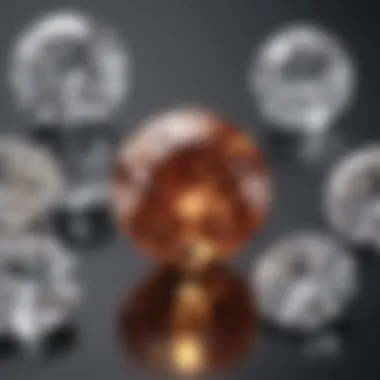
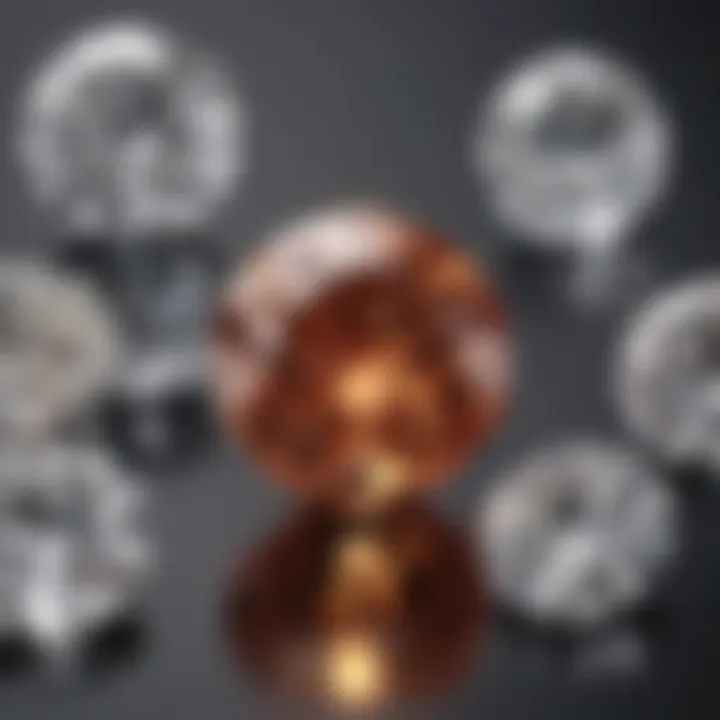
Intro
Gemstone Overview
Definition and Characteristics
A diamond, at its core, is a crystalline form of carbon, created under extreme pressure and temperature deep within the Earth. The rigidity and uniform atomic structure give a diamond its renowned durability and brilliance. When we discuss a half carat diamond, we're often referring to its weight rather than its size, which can be misleading. The term 'carat' (abbreviated as ct) is a unit of mass, with one carat equating to 200 milligrams. However, two diamonds of the same carat weight can appear vastly different in size due to various characteristics.
Classification of Gemstones
Diamonds belong to a broader category of gemstones, which can be classified in several ways:
- Natural Gemstones: Formed naturally in the Earth, like diamonds, rubies, or emeralds.
- Synthetic Gemstones: Man-made stones created to replicate natural stones, such as cubic zirconia.
- Organic Gemstones: Derived from living organisms, such as pearls and amber.
Diamonds are further classified based on their cut, color, clarity, and carat weight, commonly referred to as the "Four Cs." Each of these factors plays a crucial role in not just the appearance but the value of the diamond as well.
Historical Significance
Ancient Uses and Cultural Importance
Throughout history, diamonds have held significant value across cultures. In ancient India, diamonds were thought to hold mystical properties and were often used in religious icons. Conversely, in Europe, they were seen as a symbol of power and status among the nobility. Half carat diamonds, while smaller than others, were often chosen for their delicate appearance, offering a discreet elegance that didn't go unnoticed.
Myths and Legends Surrounding Gemstones
Diamonds are historically surronded by various myths and legends. For example, many cultures believed that diamonds could grant clear vision and high intellect to the wearer. Others held the view that these stones would protect against jealousy and fear. The sentiment surrounding half carat diamonds has evolved; they now symbolize commitment, love, and subtle sophistication—making them a particularly appealing choice for engagement rings and personal adornments.
"A diamond isn’t just a piece of jewelry, it embodies memories, hopes, and dreams, especially in the smaller sizes that speak volumes in their subtlety."
This perspective may steer buyers toward a half carat diamond, understanding that its size does not diminish its value or significance in jewelry, especially in the current market that values elegance over extravagance.
Prelims to Carat Weight
When it comes to diamonds, the term carat weight often gets thrown around as if it's the magic number that determines value. But hold your horses; there's more than meets the eye. Understanding carat weight is foundational in evaluating any diamond, especially if you're eyeing a half carat beauty. This section dives into what carat weight actually signifies and why it matters when assessing your gemstone.
Carat weight is actually a metric that quantifies how much a diamond weighs, with one carat equaling 200 milligrams. This doesn't directly translate to size, though. A half-carat diamond, for instance, can have very different dimensions depending on its cut and proportions. This is pivotal for potential buyers, as it shapes everything from aesthetics to price.
Getting a grip on carat weight helps demystify some common misconceptions; it's about more than just the number. This section will shed light on definitions and dive into the history behind this measurement, giving you the tools you need to make savvy decisions when choosing diamonds.
Definition of Carat Weight
Carat weight is often misinterpreted as the sole measure of a diamond's worth. In reality, it's just one of the criteria. Think of it as part of a bigger picture. A diamond's carat weight determines how substantial it feels, yet two diamonds of the same carat weight can look quite different depending on various factors.
Simply put, a half carat diamond weighs 0.5 carats, or 100 milligrams. But sizes can run the gamut based on how the diamond is crafted. For example, a cushion cut may take up more visual real estate than a round brilliant cut even if they share the same weight. If you want to be ahead of the game, it's crucial to assess the diamond as a whole, not just fixate on the carat weight.
Historical Context of Carat Measurement
The history of carat measurement traces back to ancient times when traders needed a way to gauge the weight of precious stones. The word "carat" itself has roots in the carob seeds used by merchants as a balance scale, due to their relatively consistent weight. Over centuries, this method did stick around, even as trade evolved.
Fast forward to the 20th century when the International System of Units standardized carat measurement to ensure clarity across markets. This step made it easier for buyers and sellers alike to navigate the often murky waters of gemstone trading.
While the history of carat might sound like merely a footnote in your diamond journey, it actually plays a role in how modern buyers perceive value today. Diamonds hailed from regions rich in history may carry a different weight—both literally and figuratively—than stones from more contemporary sources.
"Understanding the historical background of carat measurement can provide profound insight into its current implications, helping buyers appreciate the broader context of their potential purchases."
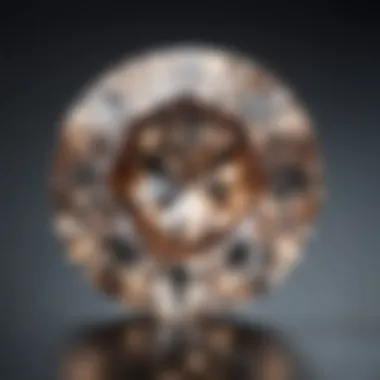
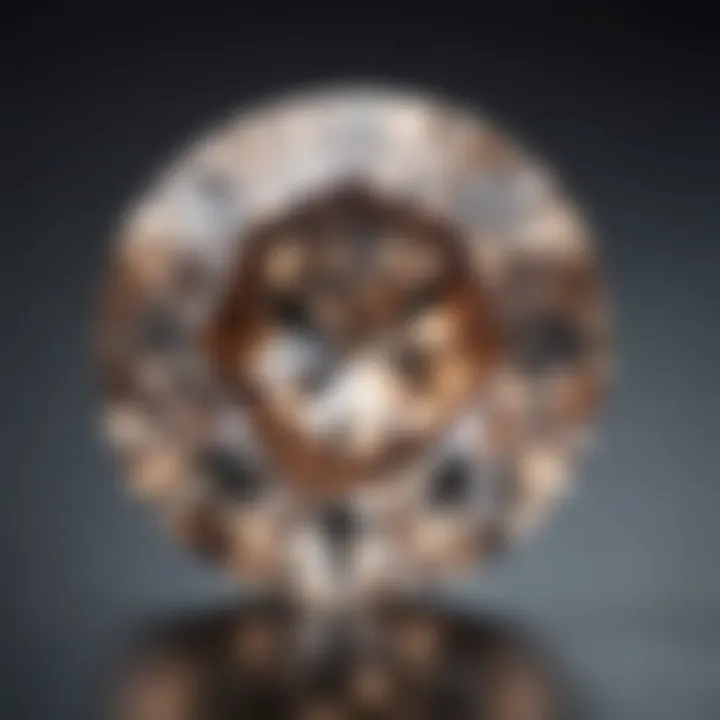
Gaining insight into these foundational aspects of carat weight is crucial for anyone looking to invest in a half carat diamond, or any diamond for that matter. As you continue through this article, you'll find that carat weight serves as more than just a number; it's a key piece of the puzzle in discerning a diamond's overall value and appeal.
The Determinants of Diamond Size
When it comes to understanding how large a diamond appears, several key factors come into play. Not only does the carat weight influence a diamond's size, but other elements like cut quality and shape are equally pivotal. The beauty and sparkle of a half carat diamond can greatly vary based on how these determinants interact. Let's break down these components one by one, allowing readers to grasp the nuances that contribute to a diamond's perceived dimensions.
Understanding Carat vs. Size
Carat weight serves as the unit of measure for diamonds, with one carat equaling 200 milligrams. However, it's a common misconception to assume that the carat weight directly translates to the physical size of the diamond. In fact, two diamonds of the same carat weight can display significantly different appearances.
This discrepancy arises because factors like cut and shape influence how light interacts with the diamond. For example, a well-cut round diamond might look larger than a similarly weighted princess cut due to the way it refracts light. Thus, while carat weight is crucial, it barely scratches the surface when assessing a diamond's actual size.
The Role of Cut Quality
Cut quality is perhaps the most critical factor in determining the appearance of a diamond. The cut refers to how well the diamond has been shaped and faceted. A deeper or shallower cut can cause the diamond to appear smaller or larger than its carat weight would suggest.
- Proportions Matter: Ideal proportions ensure optimal light reflection, which enhances sparkle. A poorly cut diamond will not scintillate as brilliantly, leading to a lackluster appearance despite its carat weight.
- Symmetry and Finish: The finish of the cut also plays a role. Well-finished diamonds exhibit a smooth surface which reflects light better, further adding to the visual impact.
In summary, the cut can enhance the perceived size and brilliance of a half carat diamond, making it a focal point to consider when selecting gemstones.
Impact of Shape on Size Perception
The shape of the diamond can greatly influence how we perceive its size. While a half carat diamond is a half carat no matter the shape, certain cuts can make it appear larger or smaller. Here’s how different shapes play a role:
- Round Cut: Generally considered the most classic, round cuts often appear larger due to their uniformity in dimensions and face-up area.
- Princess Cut: Square in shape, this cut may project more visual weight, making it seem bulkier, thus altering the size perception despite having the same carat weight.
- Marquise Cut: Known for its elongated shape, marquise diamonds can appear larger than other cuts of the same weight, as they occupy a greater surface area.
Understanding these shape nuances allows buyers to make more informed choices based on their size preferences without solely relying on carat weight.
Visual Comparison of Half Carat Diamonds
Visual comparisons are pivotal when examining gemstones, especially diamonds. The half carat diamond sits in a unique niche within the landscape of carat weights, where its size is often misinterpreted or overlooked. Engaging in visual comparison not only allows potential buyers to gauge the actual size but also helps in understanding how it relates to other weights, contributing to informed selection decisions.
One of the merits of visually comparing half carat diamonds with other sizes is to grasp the subtle yet significant differences in appearance. For instance, comparing a half carat diamond to a full carat might seem straightforward, yet the visual implications are noteworthy. The half carat may appear less dazzling on its own, but in the right context, particularly with well-selected settings, it can appear just as eye-catching. By using visual aids, buyers can piece together the idea that size isn't the sole determinant of beauty or impact.
Benefits of Visual Comparison:
- Enhanced Understanding: Seeing various carat weights side by side helps elucidate relative sizes and shapes.
- Expectation Management: Buyers can better align their expectations with reality, understanding what a half carat actually represents.
- Practical Guidance: Visual comparisons guide choices in settings that enhance perceived size and radiance.
Size Comparison with Other Carat Weights
When comparing a half carat diamond to its larger counterparts like a three-quarter carat or a full carat, a mix of majory and minors nuances come into play. A half carat diamond measures approximately 5.1 mm in diameter when round cut. In contrast, a full carat often reaches about 6.5 mm. While that difference seems minor, it results in a perceptible change in presence.
Moreover, from a market perspective, a three-quarter carat generally holds a bit more value per carat simply because it tends to look larger due to its weight. Buyers need to recognize that the visual impact may tilt heavily toward that three-quarter diamond, but preference can depend on specific tastes and styles. In settings that allow the diamond to shine, the half carat can hold its own even next to jewelry of larger weights.
Real-Life Examples and Visuals
To ground this discussion in reality, consider the experience of looking at mounted diamonds in a jewelry store. For instance, in a white gold halo setting, even a half carat diamond can appear quite sizeable due to the surrounding smaller stones reflecting light. An individual might walk in perceiving larger weights as the only option but could be pleasantly surprised by how a half carat can steal the show with the right design.
Another scenario can arise when looking at different diamond shapes. A half carat princess cut might have a different visual heft compared to the same carat weight in a marquise or oval cut. These shapes can manipulate light and thus perceived size significantly.
"The value of a diamond doesn't merely reside in its carat weight, but how it captures the light and commands attention."
Buyers should leverage visual references, perhaps utilizing tools available on ecommerce sites or social media platforms where enthusiasts share their finds.
Consider creating a visual chart or a side-by-side image comparing half carat against various weights. This brings to life the dialogue around size that often gets lost in writing.
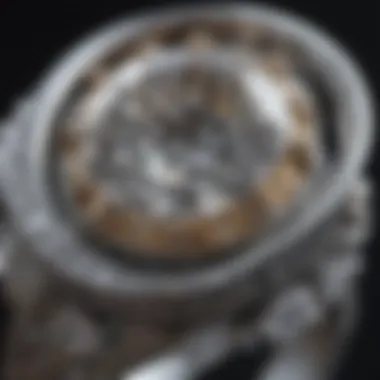
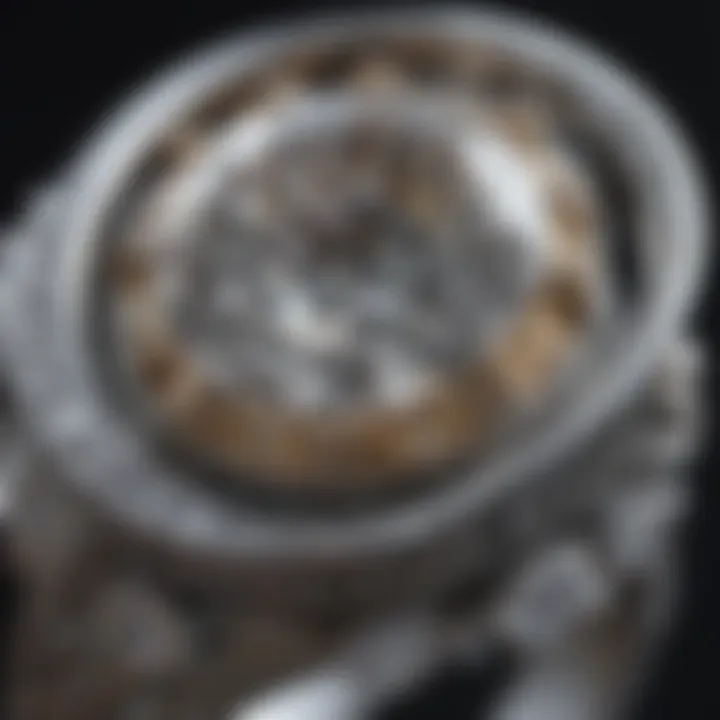
Factors Influencing the Appearance of Half Carat Diamonds
When it comes to the allure of half carat diamonds, their appearance is not simply a matter of size. Multiple factors come into play that can elevate or diminish the visual appeal of these stones. Understanding these elements can enhance one’s appreciation for the stone and provide valuable insight for anyone interested in acquiring a diamond. Color, clarity, and the setting itself represent significant influencers on how a half carat diamond can look to the naked eye.
Color and Clarity Considerations
The significance of color and clarity cannot be overlooked when assessing a half carat diamond. Diamonds are evaluated on a scale for both color and clarity, with the latter often described as the presence or absence of imperfections. A diamond’s color can range from colorless to light yellow or brown, while clarity ranges from flawless to heavily included. The interplay between these two factors shapes how light reflects and refracts within the diamond, ultimately affecting how appealing it is in terms of brilliance and fire.
- Color: A diamond with a lower color grade may appear somewhat dull, particularly when compared to a higher grade stone. A near-colorless diamond tends to reflect light in a way that is more brilliant, enhancing its visual impact. In the realm of half carat diamonds, even minor differences in color can be quite apparent, so it's crucial to choose wisely.
- Clarity: Diamonds with fewer inclusions appear cleaner, thus allowing light to travel uninterrupted through the gem. A half carat diamond that falls within the VS (Very Slightly Included) or higher clarity grades will project a brighter look compared to one with visible cloudiness or other blemishes.
"The creativity behind cut and the transparency of a diamond can either make it a gem or a pebble in the eyes of the beholder."
Setting Choices and Their Influence
When it comes to appearance, the setting of a half carat diamond can alter its perceived size and brilliance dramatically. The way a diamond is placed within its mounting can enhance its character, making it more striking or causing it to fade into the background.
Factors to consider include:
- Metal Type: Yellow gold, white gold, and platinum settings each reflect light differently. For instance, a white gold setting might enhance the diamond's natural glow, while yellow gold could create warmth that influences the overall color projection of the stone.
- Style of Setting: Whether a diamond is set in a traditional solitaire or a multi-stone layout can greatly impact its visual presentation. A solitaire setting focuses the eye solely on the diamond, giving it prominence, while pavé settings may create an illusion of increased size due to several surrounding smaller diamonds.
- Height of Setting: A diamond set higher can catch more light, which might elevate its sparkle, yet could also draw attention to its size. Alternatively, a lower setting can make a stone look larger but risks less light interaction.
Market Perceptions of Half Carat Diamonds
Understanding how half carat diamonds are perceived in the marketplace is essential for anyone considering purchasing these gemstones. Consumers often equate size with value, and this thought process can shape their buying decisions significantly. For many, a diamond's carat weight not only indicates its physical dimensions but also serves as a benchmark for quality and desirability. Recognizing this perception helps buyers navigate the intricacies of the diamond market with a more informed perspective.
Consumer Preferences and Trends
When it comes to half carat diamonds, a variety of consumer preferences around size and value emerge. Many shoppers display a preference for diamonds that are both affordable and offer enough presence to stand out, leading to half carat stones being highly regarded in engagement rings and other jewelry.
Market trends reveal that shoppers often opt for half carat diamonds because:
- Affordability: These diamonds are less costly than larger stones while still providing a considerable sparkle. This opens up options for budget-conscious buyers.
- Proportional Presence: For jewelry wearers who appreciate subtlety, a half carat diamond strikes the right balance between elegance and visibility.
- Versatile Setting Options: Half carat diamonds can be beautifully set in various styles, from classic solitaire to intricate halo settings, further appealing to diverse tastes.
An ever-growing trend includes pairing half carat diamonds with colored gemstones or smaller accent diamonds. This combination offers a unique visual appeal and showcases individuality, making it increasingly popular among those looking for distinctive pieces.
Investment Considerations
Investing in half carat diamonds can be both a calculated decision and a sentimental journey. Recognizing their potential as a long-term investment requires a careful assessment of factors that influence value over time.
Key investment points include:
- Market Demand: The demand for half carat diamonds can fluctuate based on wider market trends. Shrewd investors keep a watchful eye on supply and demand dynamics, understanding that a favorable market can enhance potential value.
- Rarity and Quality: While half carat diamonds can be more plentiful than higher carat weights, the quality of cut, color, and clarity remains paramount in valuation. Higher quality stones often fetch better prices in the marketplace.
- Future Resale Potential: Should buyers decide to part ways with their diamond, half carat stones typically maintain a reasonable resale value, especially if they possess desirable traits.
Ultimately, whether a buyer sees a half carat diamond as an investment or a personal token of love, understanding market perceptions offers a clearer view of the journey ahead in the world of gemstones.
"Investing in diamonds is as much about emotion as it is about numbers; it's necessary to find a balance between logic and sentiment."
By evaluating consumer preferences and investment considerations, potential buyers can better appreciate the overall landscape surrounding half carat diamonds.
Common Misconceptions about Half Carat Diamonds
In the world of diamonds, half carat stones often find themselves at the center of discussion, yet many misconceptions surround their value and appearance. Understanding these misconceptions is not just helpful; it’s pivotal for anyone looking to invest in or appreciate these gems fully. Having a clear picture of what a half carat diamond truly represents provides a foundation for making informed choices.
Firstly, it’s crucial to address the prevalent belief that a half carat diamond lacks the presence of larger stones. This notion can’t be further from reality. The visual appeal of a diamond is influenced by several factors beyond carat weight alone. Thus, a half carat diamond can appear strikingly large or small depending on shape, cut, and setting choice. Buyers often need to consider these elements carefully, as they can fundamentally alter how the diamond looks on the finger.
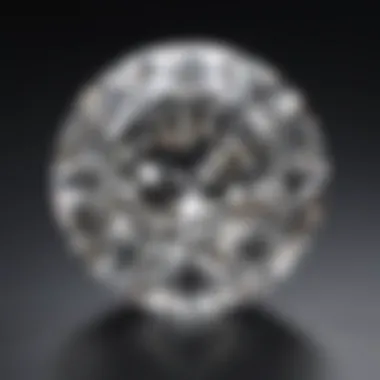
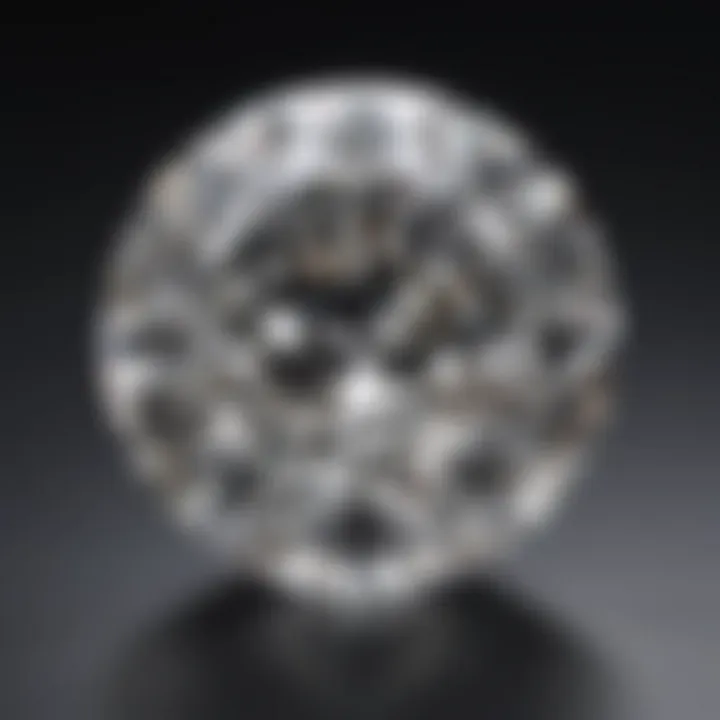
Moreover, potential buyers sometimes underestimate the emotional significance tied to a diamond's size. Bigger is often perceived as better, leading to the assumption that larger diamonds inherently make for more meaningful gifts or investments. However, many gemstone enthusiasts appreciate the charm and finesse of smaller stones, particularly when they are set thoughtfully.
Consequently, clarifying these misconceptions aids in positioning half carat diamonds in a more favorable light in the eyes of consumers. Recognizing that size can be subjective can lead to greater satisfaction with one's purchase.
Size Myths and Realities
A common myth states that all half carat diamonds look alike. In truth, the size perception can vary vastly due to the diamond's cut and shape. For instance, a round brilliant cut may appear larger than a princess cut at the same carat weight. Factors such as depth and table percentage impact how light interacts with the stone, resulting in different perceptions of size. This may shock those who have assumed that carat weight is the sole determinant of a diamond’s look.
Aside from specific cuts, some believe that a half carat diamond is small enough to be overlooked. Fortunately, in the right setting, a half carat can shine brilliantly without being diminished. Consider a delicate halo setting; it can amplify the diamond's perceived size remarkably. Or a simple four-prong setting that gives the diamond a floating appearance can make even a half carat feel grand. These aesthetics highlight the importance of choosing the right setting while focusing solely on carat weight limits the stone's potential.
Quality vs. Quantity Debate
Another serious misconception involves equating carat weight with overall quality. Some buyers think that a larger diamond automatically means a higher quality stone. However, this perspective can lead to overlooking essential factors like clarity and color. For instance, a well-cut half carat diamond can often exhibit more brilliance and fire than a poorly cut one weighing more than a whole carat.
When contemplating how to approach the quality versus quantity debate, it can be helpful to keep in mind what aspects of a diamond contribute most significantly to its beauty. The Four Cs—carat, cut, clarity, and color—are all essential to consider holistically rather than in isolation. As a result, a half carat diamond with excellent clarity and color can often outperform a larger stone of lower quality in terms of visual appeal and perceived value.
"In choosing a diamond, prioritizing quality over mere size can lead to a more fulfilling aesthetic experience."
Practical Insights for Buyers
When it comes to investing in a half carat diamond, having practical insights can make a world of difference. Many people often underestimate the importance of understanding the actual size and appearance of these stones. Knowing the nuances involved can truly elevate one's buying experience. This section aims to shed light on the specifics that matter when choosing a half carat diamond, highlighting what buyers should keep in mind as they navigate the gemstone market.
Making Informed Choices
Informed choices don’t just happen; they require a careful blend of knowledge and intuition. When selecting a half carat diamond, it’s imperative to familiarize oneself with several integral elements:
- Understand Carat vs. Size: A half carat diamond doesn’t necessarily look the same across all shapes. It's essential to familiarize yourself with how different cuts can influence perceived size.
- Cut Quality: The cut of the diamond impacts its brilliance and, hence, its visual size. A poorly cut half carat diamond may appear smaller than one with a high-quality cut.
- Color and Clarity: These factors greatly influence not just the beauty but also the perception of size. A diamond with excellent clarity and the right color grade can enhance the diamond's appearance, making it look more radiant.
- Setting Style: The choice of setting can greatly alter the visual proportions of the diamond. A well-chosen setting not only showcases the diamond but can also make it appear larger.
By gathering this knowledge, potential buyers can make choices that align with both personal preferences and overall perceptions of value.
Evaluation Factors for Selection
Evaluating a half carat diamond involves looking beyond the surface. Here are key aspects to consider:
- Expert Certification: Always ask for certification from renowned gemological institutions. This tells you about the diamond's cut, color, clarity, and carat weight, assuring its authenticity.
- Physical Examination: If possible, see the diamond in person. Hold it under various lighting conditions to assess how it sparkles and reflects light. Sometimes, a diamond that appears awesome on paper may not look as appealing in reality.
- Comparison with Similar Gems: Investigating other stones of the same carat weight but different cuts can provide perspective. It highlights how visuals can differ despite similar specifications.
- Price Versus Value: Lastly, buyers should not equate a higher price with better quality. A half carat diamond can have astounding value that doesn’t necessarily align with its monetary cost.
By blending these evaluation factors into the buying process, one can make decisions that not only meet their aesthetic desires but also ensure a solid investment in a diamond that resonates with joy and satisfaction.
"A diamond is never just a stone; it’s an experience wrapped in a tale that both reflects and refracts the spirit of its owner."
Ending: The True Value of Half Carat Diamonds
The concluding section of our exploration into half carat diamonds wraps up compelling insights about size, value, and market perceptions. It's easy to be swept away by the allure of larger stones, but this segment emphasizes that half carat diamonds hold their own unique charm and appeal. Buyers need to understand that these stones can be just as beautiful and meaningful as their heftier counterparts.
When considering a half carat diamond, one should not solely focus on the weight in carats; rather, the overall impact and personal significance are paramount. Everyone has different preferences. For some, a half carat diamond represents a sensible balance between quality and budget. Experts often suggest that cut quality, color, and clarity are critical elements that enhance a diamond's visual appeal far more than carat weight alone.
"A diamond is not just a rock; it’s a piece of art, a symbol of love, and a life milestone.”
In the world of gemstones, understanding the nuances of what a half carat diamond offers can lead to informed and rewarding purchasing decisions. It's a sweet spot that combines desirability with practicality, making it ideal for many buyers.
Final Thoughts on Size and Worth
The conversation around half carat diamonds ultimately leads to an appreciation for what these stones represent. Buying a diamond isn’t merely about acquiring a shiny object; it’s about the deeper meanings interwoven with life events—engagements, anniversaries, or simply a personal gift.
To draw a line through size and value:
- Emotional value beats carat weight. A smaller stone can carry profound sentiment, often overshadowing larger diamonds laden with little meaning.
- Quality matters. Cut quality heavily influences how a diamond sparkles, which can sometimes make a half carat diamond more appealing than a poorly cut larger stone.
- Market trends fluctuate. While larger diamonds often grab headlines, there’s a growing trend toward appreciating stones like half carats, which convey elegance without ostentation.
As gemstone enthusiasts and collectors, discerning buyers appreciate the subtleties of a half carat diamond. Rather than viewing it as lesser, understanding these stones invites a new perspective. They can serve as remarkable additions to any collection, exuding quality and craftsmanship without compromising on elegance.
In summary, embracing the true value of a half carat diamond means recognizing its unique position in both personal stories and broader market trends.







